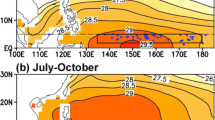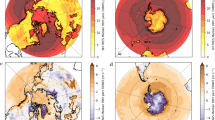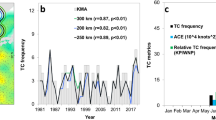Abstract
Several of the best track datasets reveal the earlier end of the tropical cyclone (TC) season over the main WNP (the east of the Philippine Islands) from 1980 to 2019, especially by the date of the upper decile of the storm days (constructed by adding one to each date if any TC exists). The enhanced vertical wind shear (VWS) during the late season (October and November) is consistent with this earlier end of the TC season. In October, the enhanced VWS is the result of the increased zonal and meridional shears, which are affected by the earlier circulation transition of the East Asian summer monsoon recessed and winter monsoon onset during late October. During November, the zonal wind shear dominates the enhanced VWS, which vertically is the opposite trend of air temperature below and above the tropopause and the meridionally opposite trend of air temperature in the north and south of 30°N. The opposite air temperature trends induce the thermal wind balance, which causes enhanced westerlies in the mid-latitudes and strong zonal shear. Three pathways increase VWS in the late season over the WNP, leading to the earlier end of the TC season. The strong impact of VWS limits TC formation, although the ambient warming underlying the surface (supports a broader and stronger potential intensity). The effect of the thermodynamical parameter, depending on relative humidity at the low and middle troposphere, is uncertain because of the inconsistent and weak trends in October between ERA5 and MERRA-2, but they both become unfavorable to TC genesis during November. The practically important meaning of the VWS for the TC season provides a possibility for future projections of the TC season.










Similar content being viewed by others
Data availability
The best track datasets are from JMA (https://www.jma.go.jp/jma/jma-eng/jma-center/rsmc-hp-pub-eg/besttrack.html), CMA (https://www.tcdata.typhoon.org.cn/en/), JTWC (https://www.metoc.navy.mil/jtwc/jtwc.html?best-tracks), and IBTrACS (https://www.ncdc.noaa.gov/ibtracs/). The reanalysis datasets are from ERA5 (http://doi.org/10.24381/cds.bd0915c6) and MERRA-2 (https://doi.org/10.5067/A7S6XP56VZWS).
References
Bister M, Emanuel KA (1998) Dissipative heating and hurricane intensity. Meteorl Atmos Phys 65:233–240. https://doi.org/10.1007/BF01030791
Bister M, Emanuel KA (2002) Low frequency variability of tropical cyclone potential intensity 1. Interannual to interdecadal variability. J Geophys Res 107:4801. https://doi.org/10.1029/2001JD000776
Camargo SJ, Emanuel KA, Sobel AH (2007) Use of a Genesis Potential Index to Diagnose ENSO Effects on Tropical Cyclone Genesis. J Climate 20:4819–4834. https://doi.org/10.1175/JCLI4282.1
Camargo SJ, Giulivi CF, Sobel AH et al (2020) Characteristics of Model Tropical Cyclone Climatology and the Large-Scale Environment. J Climate 33:4463–4487. https://doi.org/10.1175/JCLI-D-19-0500.1
Camargo SJ, Wheeler MC, Sobel AH (2009) Diagnosis of the MJO modulation of tropical cyclogenesis using an empirical index. J Atmos Sci 66:3061–3074. https://doi.org/10.1175/2009JAS3101.1
Chan JCL (1985) Tropical Cyclone Activity in the Northwest Pacific in relation to the El Niño/Southern Oscillation phenomenon. Mon Wea Rev 113:599–606. https://doi.org/10.1175/1520-0493(1985)113%3c0599:tcaitn%3e2.0.co;2
Chang M, Park D-SR, Ho C-H (2021) Possible Cause of Seasonal Inhomogeneity in Interdecadal Changes of Tropical Cyclone Genesis Frequency over the Western North Pacific. J Climate 34:635–642. https://doi.org/10.1175/JCLI-D-20-0268.1
Compo GP, Kiladis GN, Webster PJ (1999) The horizontal and vertical structure of east Asian winter monsoon pressure surges. QJR Meteorol Soc 125:29–54. https://doi.org/10.1002/qj.49712555304
Dong K, Neumann C (1986) The relationship between tropical cyclone motion and environmental geostrophic flows. Mon Weather Rev 114:115–122. http:// doi.org/https://doi.org/10.1175/1520-0493(1986)114<0115:trbtcm>2.0.co;2
Du Y, Yang L, Xie S-P (2011) Tropical Indian Ocean Influence on Northwest Pacific Tropical Cyclones in Summer following Strong El Niño. J Climate 24:315–322. https://doi.org/10.1175/2010JCLI3890.1
Dwyer JG, Biasutti M, Sobel AH (2012) Projected Changes in the Seasonal Cycle of Surface Temperature. J Climate 25:6359–6374. https://doi.org/10.1175/JCLI-D-11-00741.1
Dwyer JG, Biasutti M, Sobel AH (2014) The Effect of Greenhouse Gas-Induced Changes in SST on the Annual Cycle of Zonal Mean Tropical Precipitation. J Climate 27:4544–4565. https://doi.org/10.1175/JCLI-D-13-00216.1
Emanuel KA (1995a) Sensitivity of Tropical Cylones to Surface Exchange Coefficients and a Revised Steady-State Model Incorporating Eye Dynamics. J Atmos Sci 52:3969–3976. https://doi.org/10.1175/1520-0469(1995)052%3c3969:SOTCTS%3e2.0.CO;2
Emanuel KA (1995b) The behavior of a simple hurricane model using a convective scheme based on subcloud-layer entropy equilibrium. J Atmos Sci 52:3960–3968. https://doi.org/10.1175/1520-0469(1995)052,3960:TBOASH.2.0.CO;2
Emanuel KA (2010) Tropical cyclone activity downscaled from NOAA-CIRES Reanalysis, 1908–1958. J Adv Model Earth Syst 2:1–12. https://doi.org/10.3894/JAMES.2010.2.1
Emanuel KA (1986) An air-sea interaction theory for tropical cyclones. Part I: steady-state maintenance. J Atmos Sci 43:585–605. https://doi.org/10.1175/1520-0469(1986)043%3c0585:AASITF%3e2.0.CO;2
Emanuel KA (1987) The dependence of hurricane intensity on climate. Nature 326:483–485. https://doi.org/10.1038/326483a0
Emanuel KA (1989) The Finite-Ampliture Nature of Tropical Cyclogenesis. J Atmos Sci 46:3431–3456. https://doi.org/10.1175/1520-0469(1989)046%3c3431:TFANOT%3e2.0.CO;2
Emanuel KA, Oouchi K, Satoh M et al (2010) Comparison of Explicitly Simulated and Downscaled Tropical Cyclone Activity in a High-Resolution Global Climate Model. J J Adv Model Earth Syst 2:9. https://doi.org/10.3894/JAMES.2010.2.9
Emanuel KA, Sobel A (2013) Response of tropical sea surface temperature, precipitation, and tropical cyclone-related variables to changes in global and local forcing. J Adv Model Earth Syst 5:447–458. https://doi.org/10.1002/jame.20032
Emanuel KA, Sundararajan R, Williams J (2008) Hurricanes and Global Warming: Results from Downscaling IPCC AR4 Simulations. Bull Amer Meteor Soc 89:347–368. https://doi.org/10.1175/BAMS-89-3-347
Fan K (2007) North Pacific sea ice cover, a predictor for the Western North Pacific typhoon frequency? SCI CHINA SER D 50:1251–1257. https://doi.org/10.1007/s11430-007-0076-y
Gao C, Robock A, Ammann C (2008) Volcanic forcing of climate over the past 1500 years: An improved ice core-based index for climate models. J Geophys Res 113:D23111. https://doi.org/10.1029/2008JD010239
Gelaro R, McCarty W, Suárez MJ et al (2017) The Modern-Era Retrospective Analysis for Research and Applications, Version 2 (MERRA-2). J Climate 30:5419–5454. https://doi.org/10.1175/JCLI-D-16-0758.1
Gray WM (1975) TROPICAL CYCLONE GENESIS. Department of Atmospheric Science, Fort Collins, Colorado
Gray WM (1968) Global view of the origin of tropical disturbances and storms. Monthly Weather Review 96:669–700. http:// doi.org/https://doi.org/10.1175/1520-0493(1968)0962.0.CO;2
Gray WM (1979) Hurricanes : Their formation, structure and likely role in the tropical circulation. Meteorology over the Tropical Oceans 155–218
Gualdi S, Scoccimarro E, Navarra A (2008) Changes in Tropical Cyclone Activity due to Global Warming: Results from a High-Resolution Coupled General Circulation Model. J Climate 21:5204–5228. https://doi.org/10.1175/2008JCLI1921.1
Guo QY (1983) The summer monsoon intensity index in East Asia and its variation. Acta Geogr Sin 38:207–216
Hsu P-C, Chu P-S, Murakami H, Zhao X (2014) An Abrupt Decrease in the Late-Season Typhoon Activity over the Western North Pacific*. J Climate 27:4296–4312. https://doi.org/10.1175/JCLI-D-13-00417.1
Huangfu J, Huang R, Chen W et al (2017) Interdecadal variation of tropical cyclone genesis and its relationship to the monsoon trough over the western North Pacific: INTERDECADAL VARIATION OF WNP TC GENESIS AND ITS RELATIONSHIP TO MT. Int J Climatol 37:3587–3596. https://doi.org/10.1002/joc.4939
Ihara C, Kushnir Y (2009) Change of mean midlatitude westerlies in 21st century climate simulations. Geophys Res Lett 36:L13701. https://doi.org/10.1029/2009GL037674
Karloski JM, Evans C (2016) Seasonal Influences upon and Long-Term Trends in the Length of the Atlantic Hurricane Season. J Climate 29:273–292. https://doi.org/10.1175/JCLI-D-15-0324.1
Kim D, Kim H-S, Park D-SR, Park M-S (2017) Variation of the Tropical Cyclone Season Start in the Western North Pacific. J Climate 30:3297–3302. https://doi.org/10.1175/JCLI-D-16-0888.1
Kim H-M, Webster PJ, Curry JA (2009) Impact of Shifting Patterns of Pacific Ocean Warming on North Atlantic Tropical Cyclones. Science 325:77–80. https://doi.org/10.1126/science.1174062
Knapp KR, Kruk MC (2010) Quantifying Interagency Differences in Tropical Cyclone Best-Track Wind Speed Estimates. Mon Wea Rev 138:1459–1473. https://doi.org/10.1175/2009MWR3123.1
Korty RL, Camargo SJ, Galewsky J (2012a) Tropical Cyclone Genesis Factors in Simulations of the Last Glacial Maximum. J Climate 25:4348–4365. https://doi.org/10.1175/JCLI-D-11-00517.1
Korty RL, Camargo SJ, Galewsky J (2012b) Variations in Tropical Cyclone Genesis Factors in Simulations of the Holocene Epoch. J Climate 25:8196–8211. https://doi.org/10.1175/JCLI-D-12-00033.1
Korty RL, Emanuel KA, Huber M, Zamora RA (2017) Tropical Cyclones Downscaled from Simulations with Very High Carbon Dioxide Levels. J Climate 30:649–667. https://doi.org/10.1175/JCLI-D-16-0256.1
Kossin JP (2018) A global slowdown of tropical-cyclone translation speed. Nature 558:104–107. https://doi.org/10.1038/s41586-018-0158-3
Kossin JP (2008) Is the North Atlantic hurricane season getting longer? Geophys Res Lett 35:L23705. https://doi.org/10.1029/2008GL036012
Kossin JP, Emanuel KA, Vecchi GA (2014) The poleward migration of the location of tropical cyclone maximum intensity. Nature 509:349–352. https://doi.org/10.1038/nature13278
Kossin JP, Olander TL, Knapp KR (2013) Trend Analysis with a New Global Record of Tropical Cyclone Intensity. J Climate 26:9960–9976. https://doi.org/10.1175/JCLI-D-13-00262.1
Lander M (1994) An Exploratory Analysis of the relationship between tropical storm formation in the Western North Pacific and ENSO. Mon Wea Rev 22:635–651. http:// doi.org/https://doi.org/10.1175/1520-0493(1994)122<0636:AEAOTR>2.0.CO;2
Lawton QA, Korty RL, Zamora RA (2021) Tropical Cyclones Downscaled from Simulations of the Last Glacial Maximum. J Climate 34:659–674. https://doi.org/10.1175/JCLI-D-20-0409.1
Lee C-Y, Camargo SJ, Vitart F et al (2018) Subseasonal Tropical Cyclone Genesis Prediction and MJO in the S2S Dataset. Wea Forecasting 33:967–988. https://doi.org/10.1175/WAF-D-17-0165.1
Luo B, Minnett PJ, Szczodrak M et al (2020) Accuracy Assessment of MERRA-2 and ERA-Interim Sea Surface Temperature, Air Temperature, and Humidity Profiles over the Atlantic Ocean Using AEROSE Measurements. J Climate 33:6889–6909. https://doi.org/10.1175/JCLI-D-19-0955.1
Luo Z (2001) Effects of tropical cyclone on the short time scale evolution of subtropical high. Acta Geogr Sin 59:549–559. https://doi.org/10.3321/j.issn:0577-6619.2001.05.005
Maloney ED, Hartmann DL (2001) The Madden–Julian Oscillation, Barotropic Dynamics, and North Pacific Tropical Cyclone Formation. Part i: Observations J Atmos Sci 58:2545–2558. https://doi.org/10.1175/1520-0469(2001)0582.0.CO;2
Murakami H, Delworth TL, Cooke WF et al (2020) Detected climatic change in global distribution of tropical cyclones. Proc Natl Acad Sci USA 117:10706–10714. https://doi.org/10.1073/pnas.1922500117
Nolan DS (2011) Evaluating Environmental Favorableness for Tropical Cyclone Development with the Method of Point-Downscaling. J Adv Model Earth Syst 3:M08001. https://doi.org/10.1029/2011MS000063
Palmen E (1948) On the formation and structure of tropical hurricanes. Geophysica 26–38
Rios-Berrios R, Davis CA, Torn RD (2018) A Hypothesis for the Intensification of Tropical Cyclones under Moderate Vertical Wind Shear. J Atmos Sci 75:4149–4173. https://doi.org/10.1175/JAS-D-18-0070.1
Rios-Berrios R, Torn RD (2017) Climatological Analysis of Tropical Cyclone Intensity Changes under Moderate Vertical Wind Shear. Mon Weather Rev 145:1717–1738. https://doi.org/10.1175/MWR-D-16-0350.1
Royer JF, Chauvin F, Timbal B (1998) A GCM Study of the Impact of Greenhouse Gas Increase on the Frequency of Occurrence of Tropical Cyclones. Climatic Change 38:307–343. http:// doi.org/ https://doi.org/10.1023/A:1005386312622
Sen PK (1968) Estimates of the regression coefficient based on Kendall’s tau. J Am Stat Assoc 63:1379–1389. https://doi.org/10.2307/2285891
Shaw TA (2019) Mechanisms of Future Predicted Changes in the Zonal Mean Mid-Latitude Circulation. Curr Clim Change Rep 5:345–357. https://doi.org/10.1007/s40641-019-00145-8
Son S-W, Polvani LM, Waugh DW et al (2009) The Impact of Stratospheric Ozone Recovery on Tropopause Height Trends. J Climate 22:429–445. https://doi.org/10.1175/2008JCLI2215.1
Tang B, Camargo SJ (2014) Environmental control of tropical cyclones in CMIP5: A ventilation perspective: VENTILATION OF CMIP5 TROPICAL CYCLONES. J Adv Model Earth Syst 6:115–128. https://doi.org/10.1002/2013MS000294
Tang B, Emanuel K (2012) A Ventilation Index for Tropical Cyclones. Bull Amer Meteor Soc 93:1901–1912. https://doi.org/10.1175/BAMS-D-11-00165.1
Tang BH, Neelin JD (2004) ENSO Influence on Atlantic hurricanes via tropospheric warming. Geophys Res Lett 31:L24204. https://doi.org/10.1029/2004GL021072
Theil H (1950) A rank-invariant method of linear and polynomial regression analysis. I, II, III. the Proceedings of the Royal Netherlands Academy of Sciences 53:386–392, 521–525, 1397–1412
Tippett MK, Camargo SJ, Sobel AH (2011) A Poisson Regression Index for Tropical Cyclone Genesis and the Role of Large-Scale Vorticity in Genesis. J Climate 24:2335–2357. https://doi.org/10.1175/2010JCLI3811.1
Wang B, Chan JCL (2002) How Strong ENSO Events Affect Tropical Storm Activity over the Western North Pacific. J Climate 15:1643–1658. http:// doi.org/https://doi.org/10.1175/1520-0442(2002)0152.0.CO;2
Wang B, Fan Z (1999) Choice of South Asian Summer Indices. Bull Am Meteor Soc 80:629–638. https://doi.org/10.1175/1520-0477(1999)080<0629:cosasm>2.0.co;2
Wang B, Wu R, Lau WKM (2001) Interannual Variability of the Asian Summer Monsoon: Contrasts between the Indian and the Western North Pacific–East Asian Monsoons. J Climate 14:4073–4091. https://doi.org/10.1175/1520-0442(2001)014<4073:IVOTAS>2.0.CO;2
Wang S, Rashid T, Throp H, Toumi R (2020) A Shortening of the Life Cycle of Major Tropical Cyclones. Geophysical Research Letters 47:e2020GL088589. https://doi.org/10.1029/2020GL088589
Webster PJ (2005) Changes in Tropical Cyclone Number, Duration, and Intensity in a Warming Environment. Science 309:1844–1846. https://doi.org/10.1126/science.1116448
Webster PJ (1987) The elementary monsoon. in monsoon. John Wiley, New York, pp 3–32
Wong MLM, Chan JCL (2004) Tropical Cyclone Intensity in Vertical Wind Shear. J Atmos Sci 61:1859–1876. https://doi.org/10.1175/1520-0469(2004)061%3c1859:TCIIVW%3e2.0.CO;2
Wu Y, Huang F, Xu S, Xing W (2020) Prediction of accumulated cyclone energy in tropical cyclone over the western North Pacific in autumn. Clim Dyn 55:3327–3342. https://doi.org/10.1007/s00382-020-05449-2
Wu Y, Korty RL (2022) Changes in the length of the season with favorable environmental conditions for tropical cyclones in the North Atlantic basin during the last 40 years. J Climate 35:5237–5256. https://doi.org/10.1175/JCLI-D-21-0767.1
Xu S, Wang B (2014) Enhanced western North Pacific tropical cyclone activity in May in recent years. Clim Dyn 42:2555–2563. https://doi.org/10.1007/s00382-013-1921-7
Zhan R, Wang Y, Lei X (2011) Contributions of ENSO and East Indian Ocean SSTA to the Interannual Variability of Northwest Pacific Tropical Cyclone Frequency. J Climate 24:509–521. https://doi.org/10.1175/2010JCLI3808.1
Zhao J, Zhan R, Wang Y, Xu H (2018) Contribution of the Interdecadal Pacific Oscillation to the Recent Abrupt Decrease in Tropical Cyclone Genesis Frequency over the Western North Pacific since 1998. J Climate 31:8211–8224. https://doi.org/10.1175/JCLI-D-18-0202.1
Zheng Y, Wu L, Zhao H et al (2020) Simulation of Extreme Updrafts in the Tropical Cyclone Eyewall. Adv Atmos Sci 37:781–792. https://doi.org/10.1007/s00376-020-9197-4
Zhu C, He J, Wu GX (2000) East Asian monsoon index and its interannual relationship with large-scale thermal dynamical circulation. Acta Geogr Sin 58:391–402
Acknowledgements
We thank Dr. Robert Korty at Texas A&M University; he gave a lot of help with this earlier work. Thanks for the CMIP5 project and the International Laboratory for High-Resolution Earth System Prediction. We thank two anonymous reviewers for their constructive comments, which greatly improved the original draft of this paper.
Funding
Thank you for the Council Scholarship of China providing the funding. The work is supported by the Shandong Natural Science Foundation Project (ZR2019ZD12) and the National Science Foundation of China (41975061).
Author information
Authors and Affiliations
Corresponding author
Ethics declarations
Conflict of interest
The authors have no competing interests to declare that are relevant to the content of this article.
Additional information
Publisher's Note
Springer Nature remains neutral with regard to jurisdictional claims in published maps and institutional affiliations.
Supplementary Information
Below is the link to the electronic supplementary material.
Rights and permissions
Springer Nature or its licensor (e.g. a society or other partner) holds exclusive rights to this article under a publishing agreement with the author(s) or other rightsholder(s); author self-archiving of the accepted manuscript version of this article is solely governed by the terms of such publishing agreement and applicable law.
About this article
Cite this article
Wu, Y., Huang, F. & Xu, S. The earlier end of the tropical cyclone season over the Western North Pacific by environmental cyclogenesis factors. Clim Dyn 61, 1293–1309 (2023). https://doi.org/10.1007/s00382-022-06627-0
Received:
Accepted:
Published:
Issue Date:
DOI: https://doi.org/10.1007/s00382-022-06627-0




